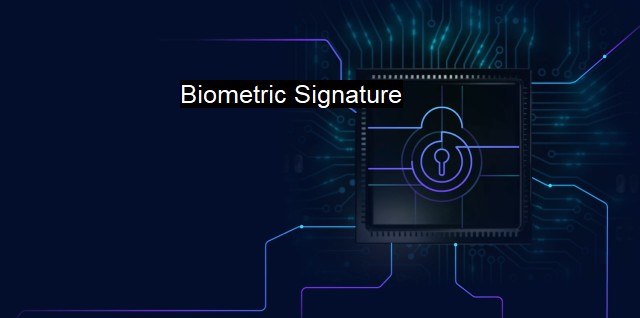What is Biometric Signature?
The Power of Biometric Technology: Exploring Dynamic Authentication Techniques and the Rise of Biometric Signatures in Security
Biometric Signature is one of the most advanced, innovative forms of cybersecurity designed to optimize the effectiveness and efficiency of antivirus systems. It refers to the unique, measurable characteristics that are used to label and describe individuals' identities. Biometric signatures are scientifically constructed of elements derived from each unique user's physical attributes, physiological characteristics or behavioral traits.These biometric markers could be as diverse as fingerprints, facial patterns, voice or typing cadences, or even iris configuration. For instance, in medicine, heart electrocardiograms are being explored as identifiers for personal authentication, while high-security facilities often depend on retinal scanners for access control.
The significant advantage of these biometric signatures is that unlike traditional forms of security measures – like passwords or personal identification numbers which can be guessed, lost, stolen, forgotten, or compromised – biometric signatures are intrinsic. They represent an individual’s unique features which cannot be replicated, providing unrivaled levels of securities.
One of the marvelous examples of biometric authentication in use today is the fingerprint scanner on smartphones or laptops. Instead of entering a four-digit pin or a complicated alphanumeric password, this technology simply requires the touch of a finger. It uses intricate detailing of the fingerprint ridge patterns that are unique for every individual, providing secure access based on these biological distinctions.
It’s crucial to note that while biometric signatures add an extra layer of impenetrable defense, they are not without their challenges. For one, it often violates the privacy of users. For instance, to employ facial recognition, companies start by creating a vast database of faces from diversified public sources and without getting specific consent. That generates serious ethical and legal privacy questions.
Once biometric data is compromised, it is significantly challenging, if not, impossible to restore security when compared with traditional identifiers that can simply be altered—an instance where a hacker manages to reproduce the biometric data of an individual could compromise this individual's identity permanently.
Since biometric signatures solidify an individual’s identity and turn it into a form of primordial defense against unauthorized or unlawful access, it revolutionizes how antivirus systems operate. Traditionally, antivirus systems scoured through computing files and patterns to identify any unusual or harmful activities. These systems often consume significant computing power, slow down the device, and lead to false positives around suspicious activities.
Biometric signatures can change this paradigm significantly by not only hardening data access controls, restating emphasis on proactivity over securing digital systems but it also aids antivirus systems to focus more system resources on core functions such as scanning for viruses, rooting out malicious software, and securing networks against intruders.
It reduces the need for repetitively identifying users, thereby cutting down on overwhelm and false alarms. Excessive alarms have been known to desensitize users and engineers alike, often reducing the urgency or attention a real threat requires. Biometrics reduces that risk by bringing personalized identities to the cybersecurity landscape.
It is undeniable that biometric signatures pave the way for a safer digital world. Despite the privacy concerns and challenging dynamics they ring in, an environment where physical, biological, and digital aspects blend can provide better security across the board. It obviously complements existing antivirus systems with enhanced efficiency and effectiveness, curbing cyber intrusions more rigorously. By prioritizing biometrics identification, companies can shore up defenses considerably in this increasingly insecure digital environment. Therefore, the right balance between this technology and ethical standards needs to be established moving forward.

Biometric Signature FAQs
What is a biometric signature?
A biometric signature is a unique digital representation of an individual's behavior, such as the way they write or move their mouse. It is used as a security measure to authenticate the identity of the user and prevent unauthorized access to sensitive information.How does a biometric signature work in antivirus software?
Antivirus software can use a biometric signature to detect and prevent malware from executing on a system. The software compares the behavior of the software attempting to execute with the known behavior of legitimate programs, and if there are discrepancies, the software is flagged and prevented from running.Can a biometric signature be copied or stolen?
A biometric signature is difficult to copy or steal since it is based on unique behavioral patterns. However, if an attacker gains access to the device or system where the biometric signature is stored, they may be able to manipulate or copy it. That is why it is crucial to keep the device or system secure and use strong authentication factors to protect sensitive information.What are the benefits of using biometric signatures in cybersecurity?
The use of biometric signatures in cybersecurity offers several benefits such as high accuracy, less reliance on traditional passwords, and prevention of unauthorized access to sensitive information. Biometric signatures are difficult to replicate, making them a strong security measure against attacks such as phishing and social engineering.| | A | | | B | | | C | | | D | | | E | | | F | | | G | | | H | | | I | | | J | | | K | | | L | | | M | |
| | N | | | O | | | P | | | Q | | | R | | | S | | | T | | | U | | | V | | | W | | | X | | | Y | | | Z | |
| | 1 | | | 2 | | | 3 | | | 4 | | | 7 | | | 8 | | |||||||